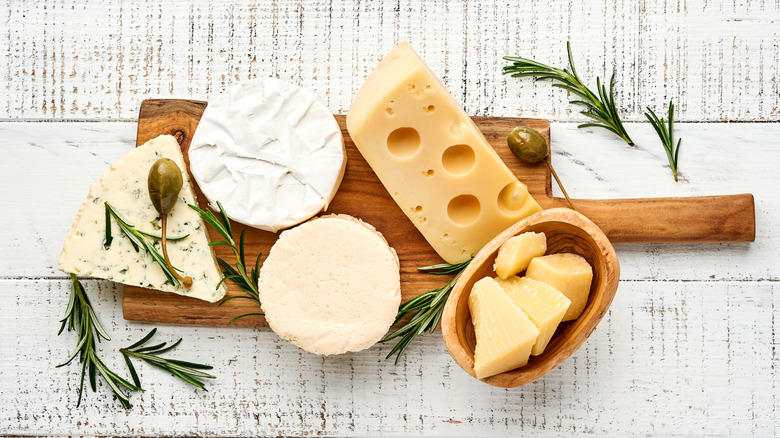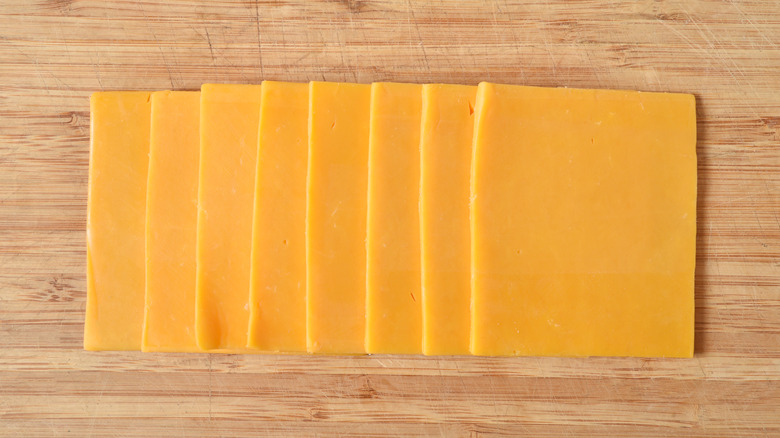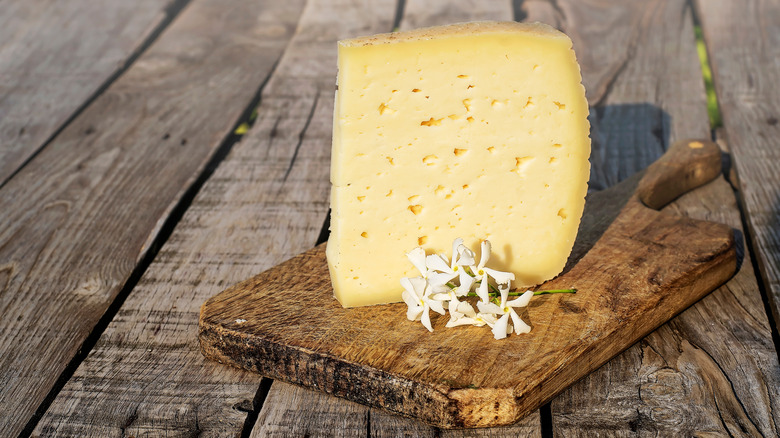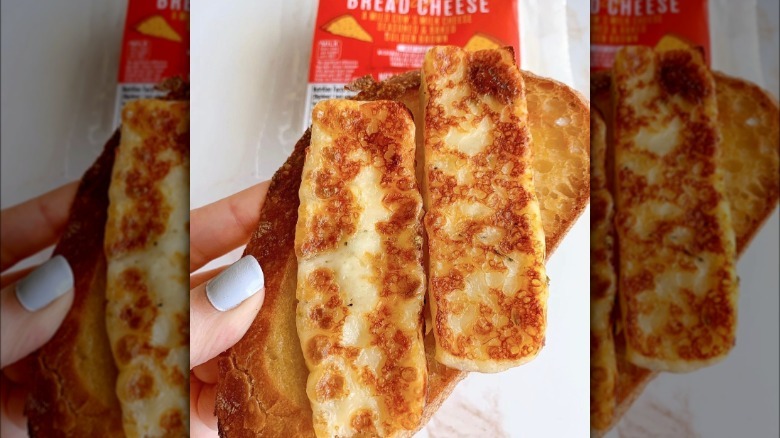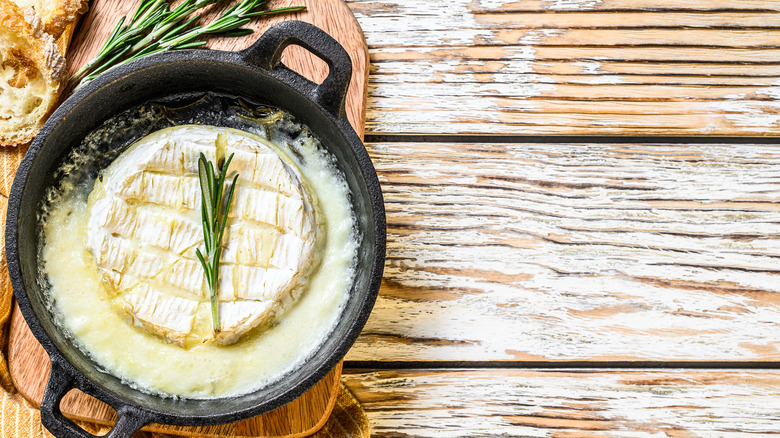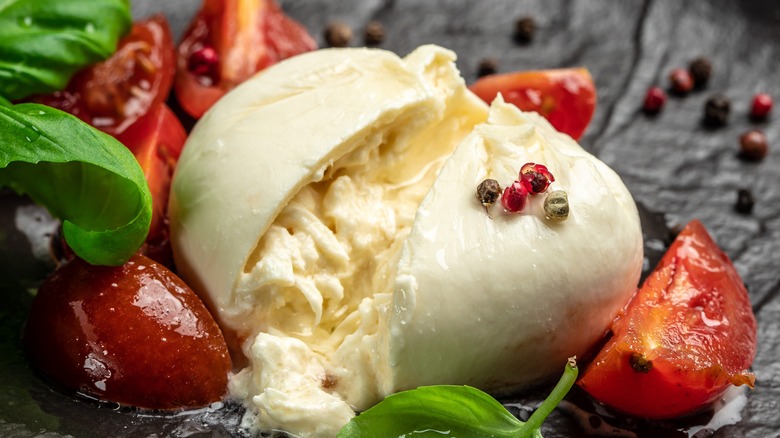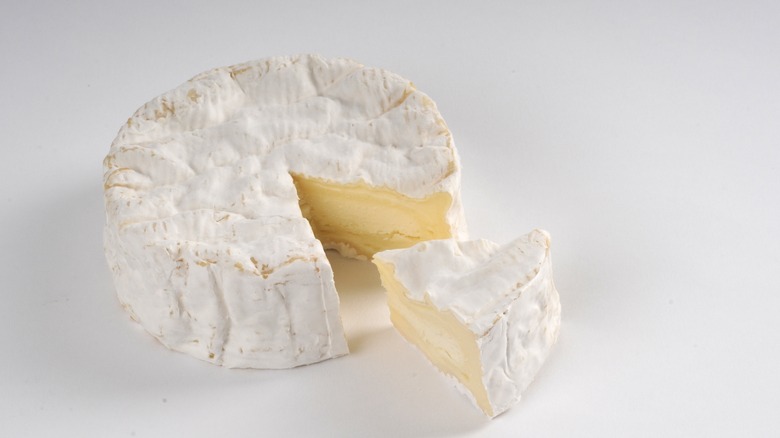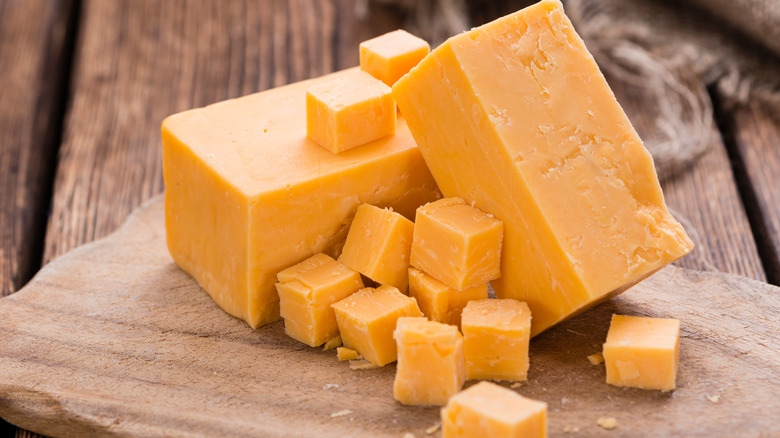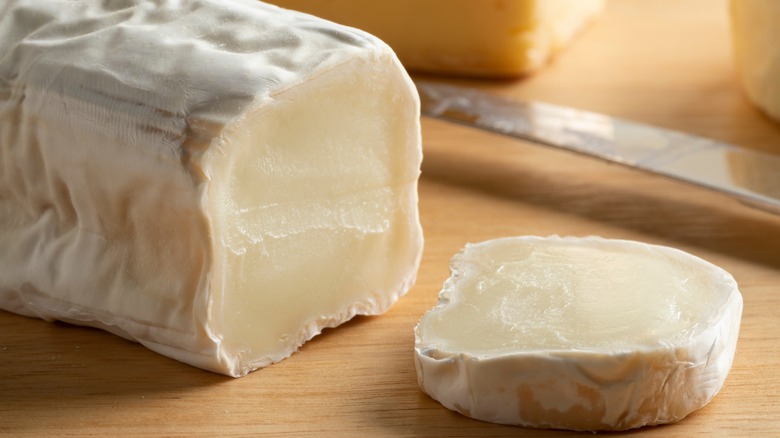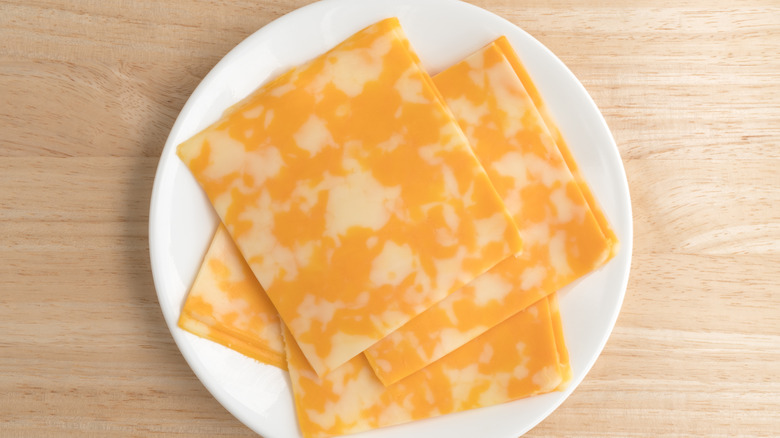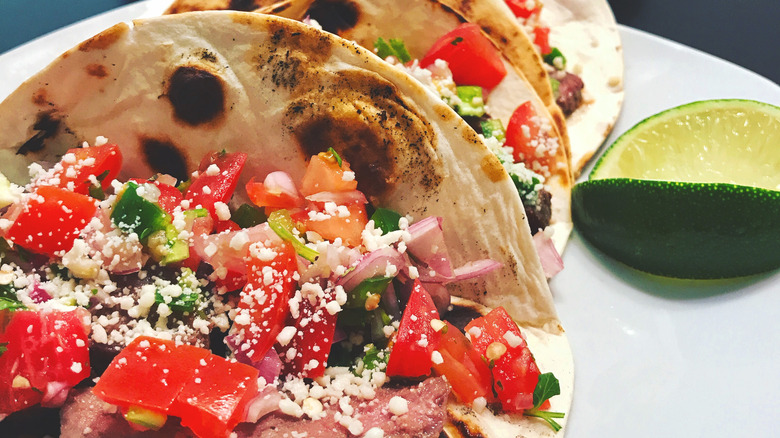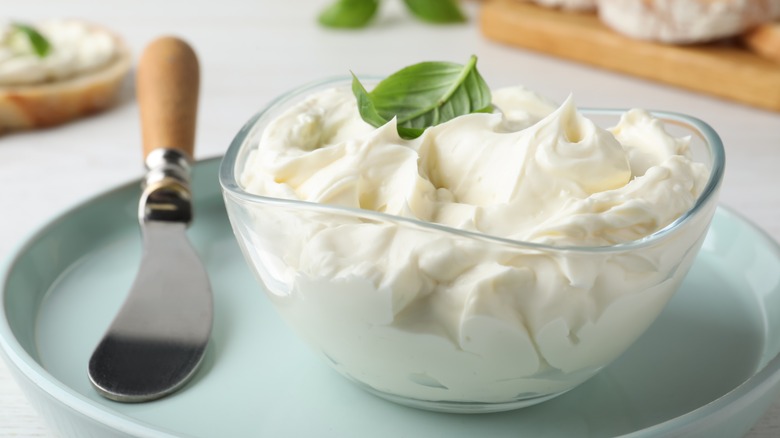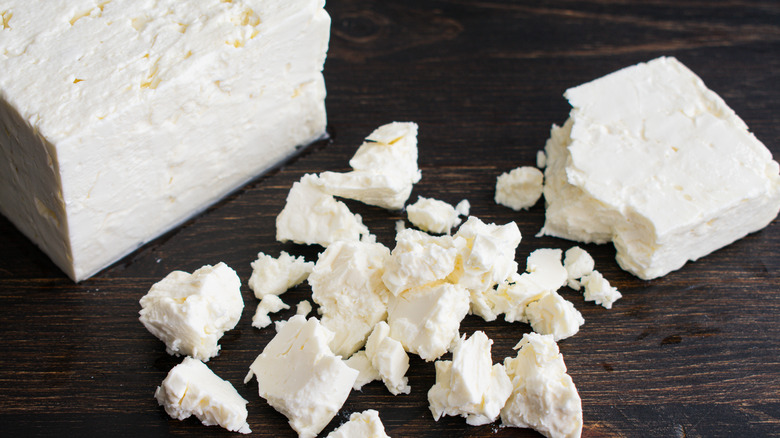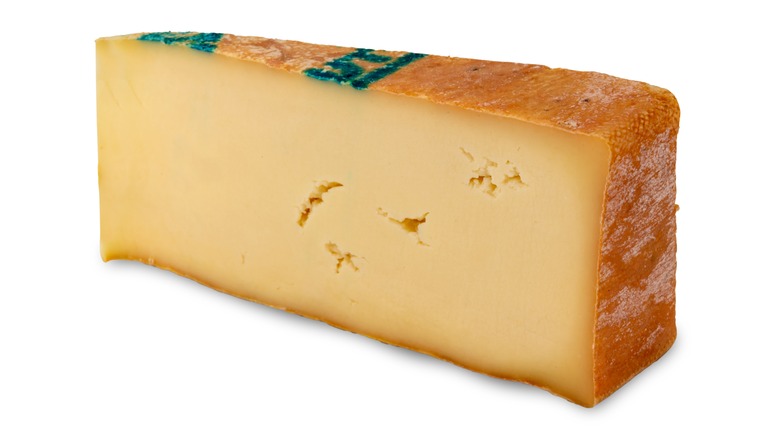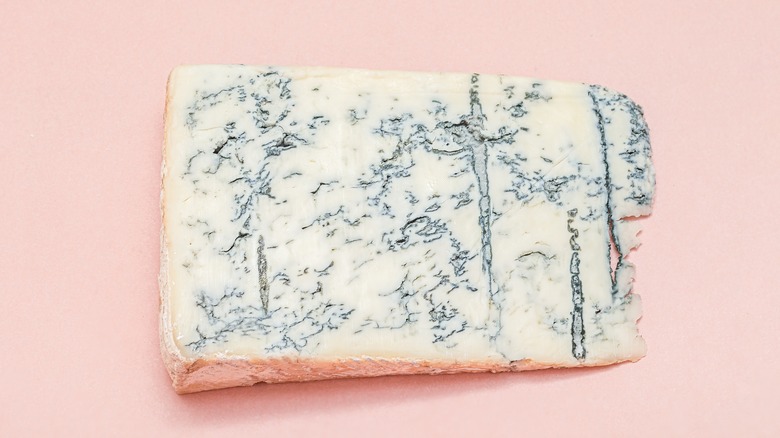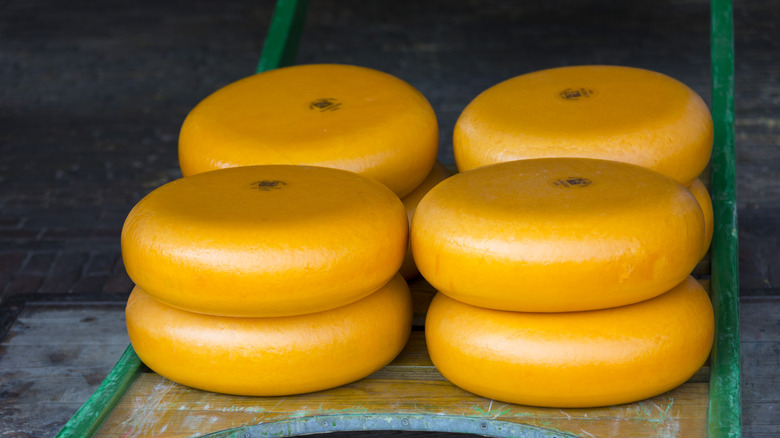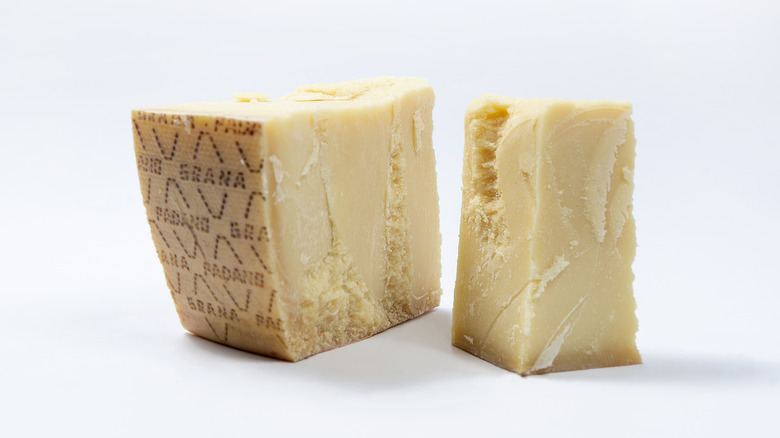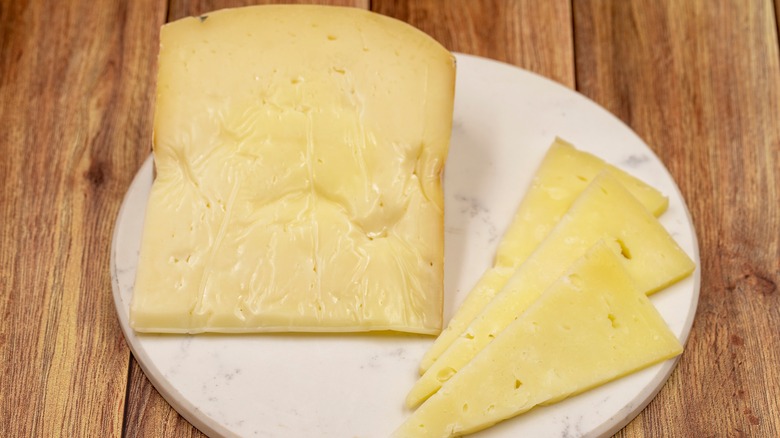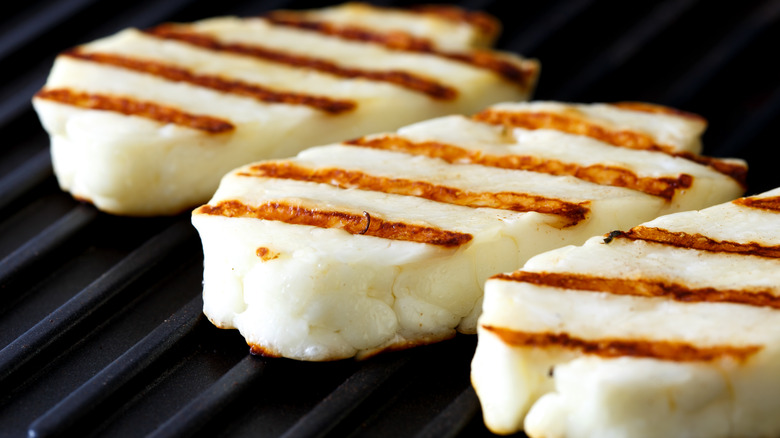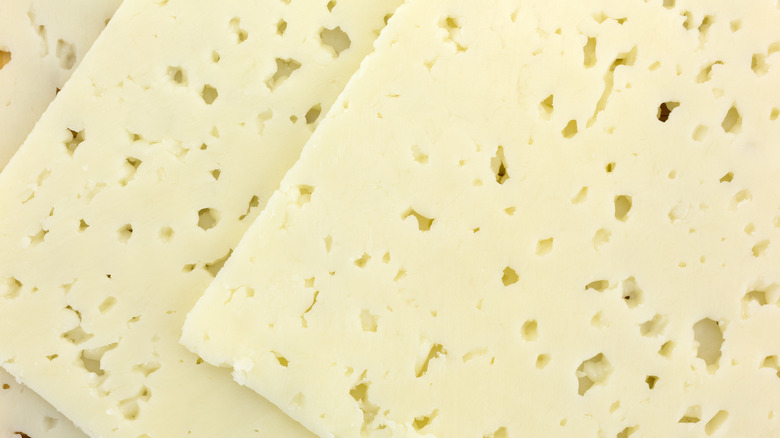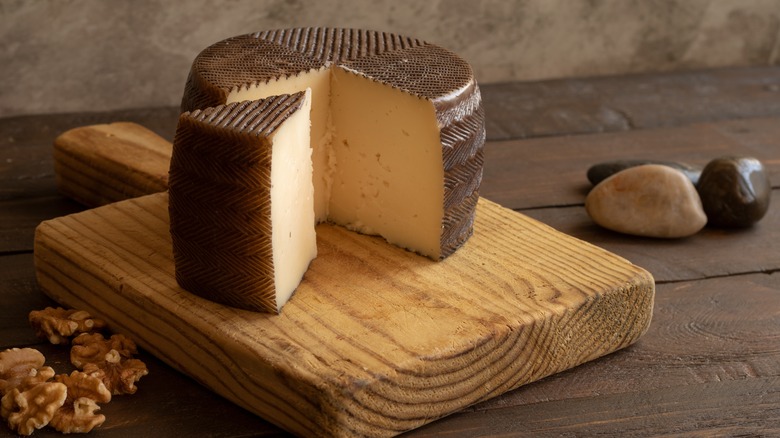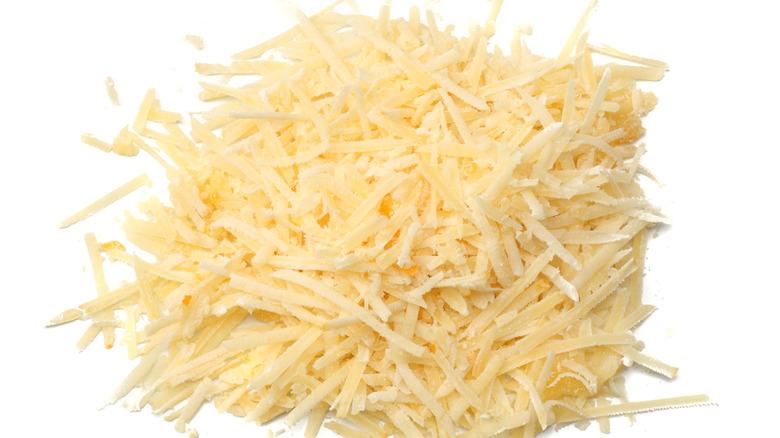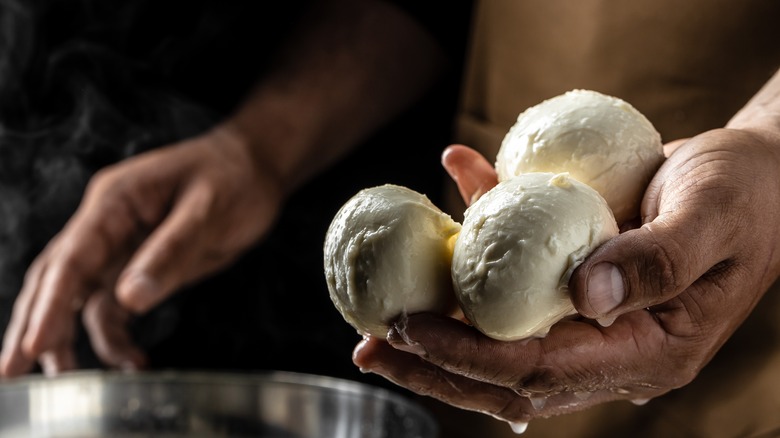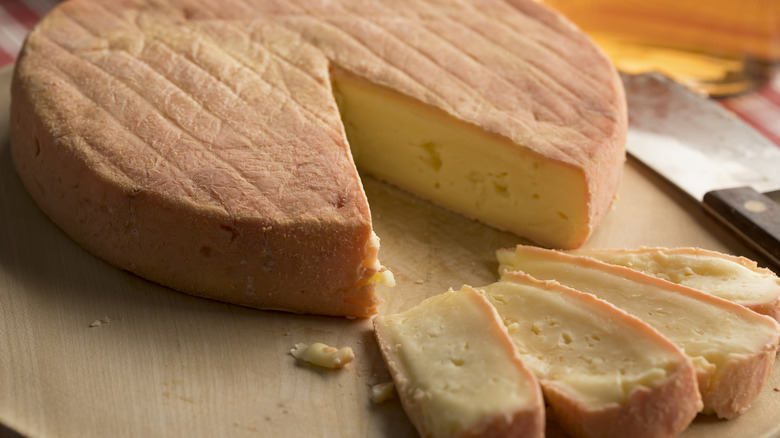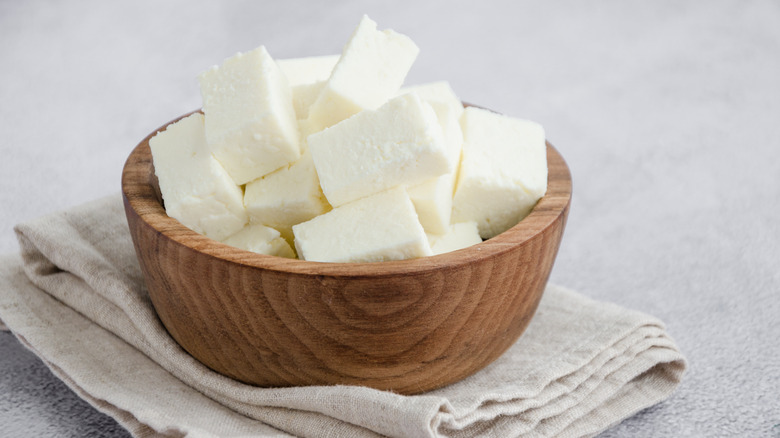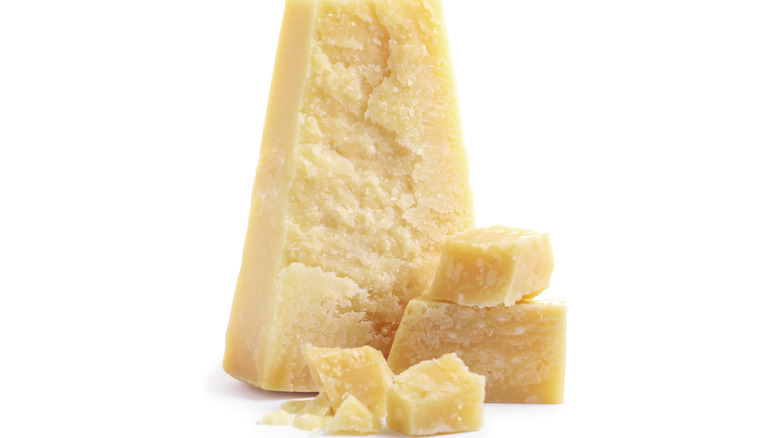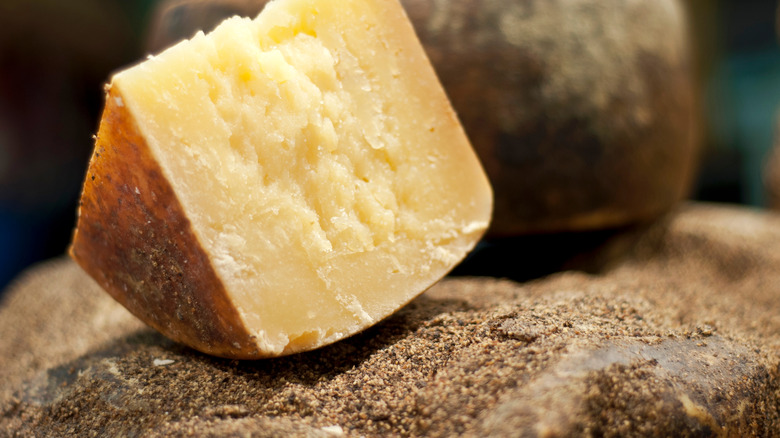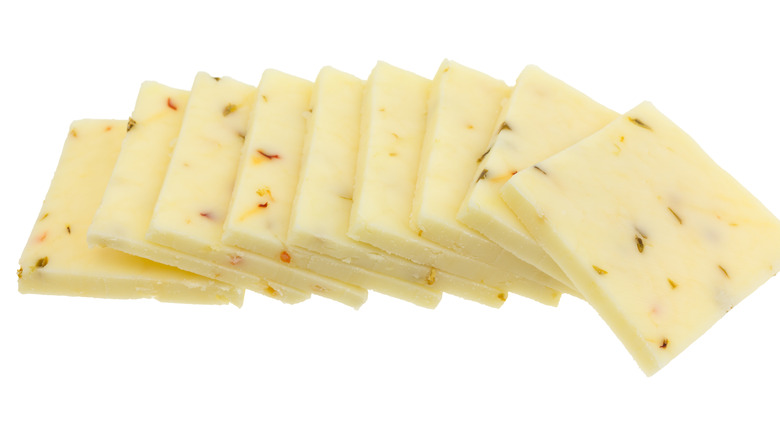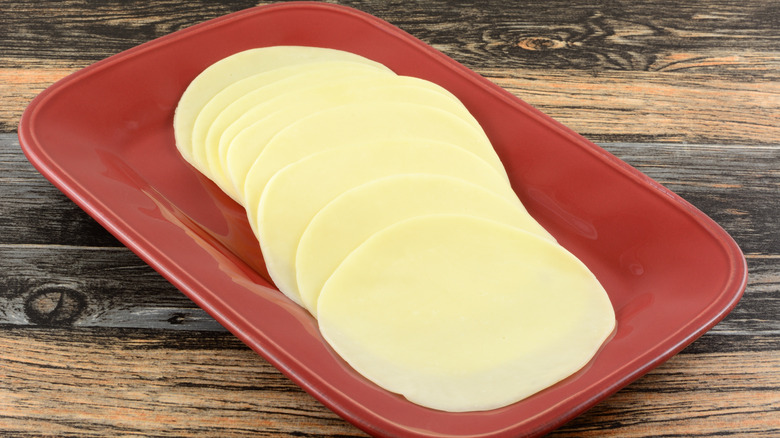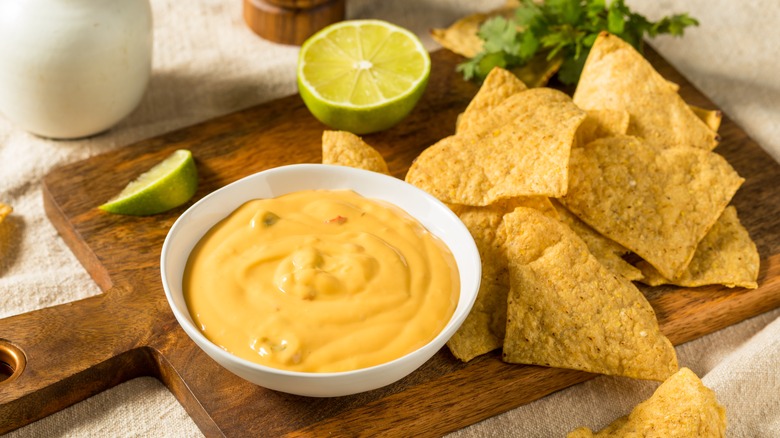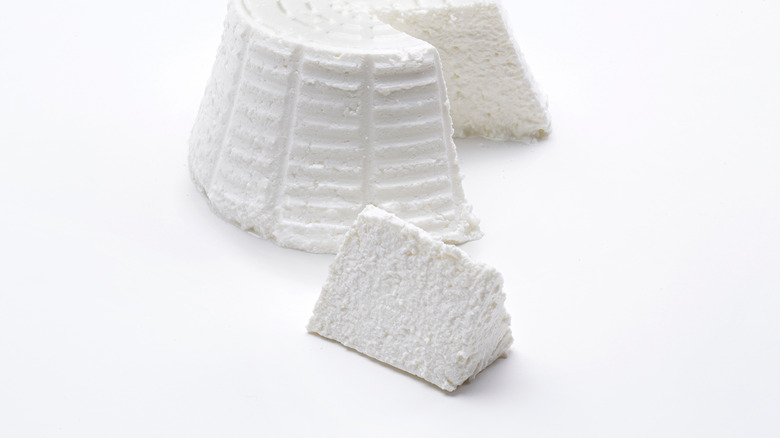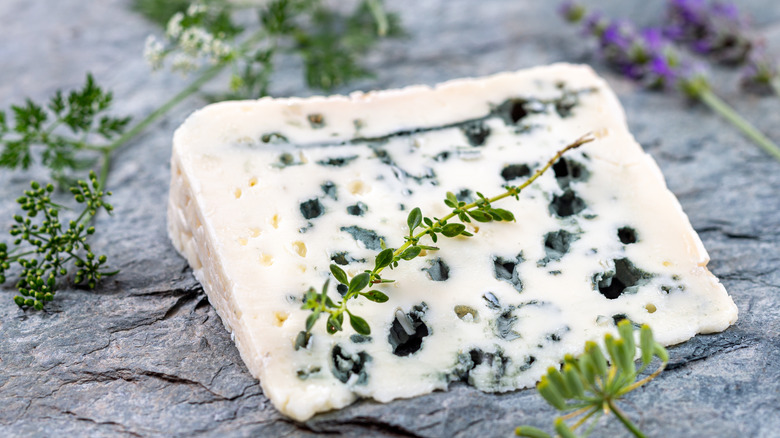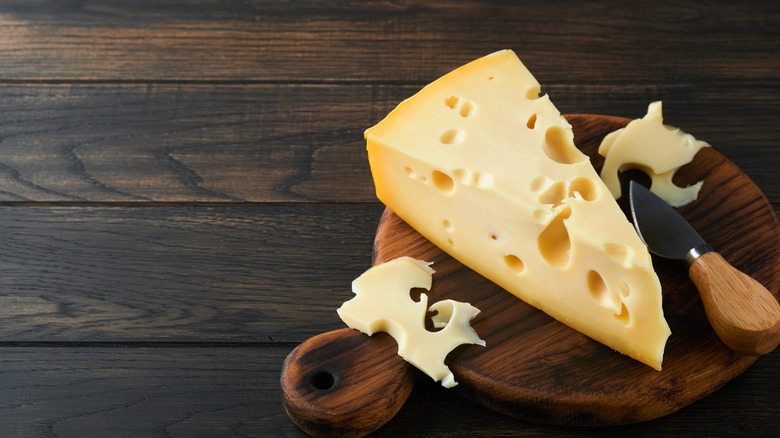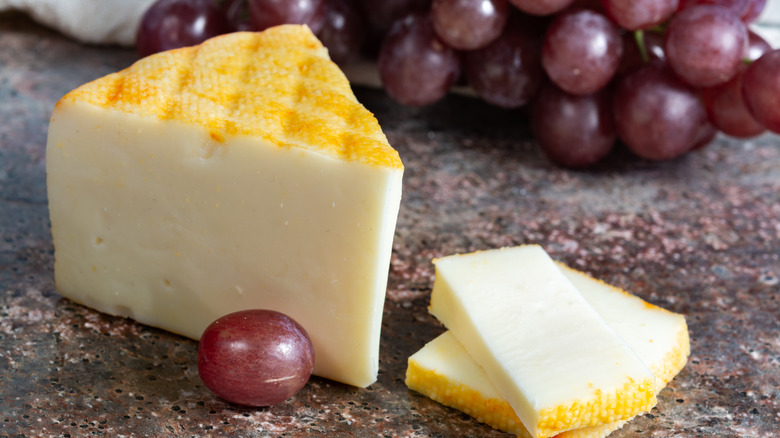35 Types Of Cheese, Explained
Cheese is almost as old as time itself. According to the International Dairy Foods Association, legend has it that the first cheese was created close to 4,000 years ago when an Arabian merchant placed milk in a pouch made from sheep intestines. The heat from the sun combined with the lining of the pouch caused the cheese to separate into solid curds that the merchant could eat.
The movement of trade across Asia and Europe brought the basic science of cheesemaking to other countries, where the process was refined to include preservation and flavoring processes like salting, cooking, and pressing.
There are several categories of cheese that help us sort through the lexicon of cheese types. There are fresh cheeses, rinded cheese, hard cheeses, and flavor-added varieties that dominate cheese coolers in grocery stores and artisan cheese shops around the world. Some cheeses are incredibly popular and should definitely be part of your next charcuterie board.
1. American
American cheese is often synonymous with "processed cheese." Entrepreneur James L. Kraft patented the first shelf-stable, cheddar-based processed cheese in 1916. But this cheese didn't look like the American cheese you put on your grilled cheese sandwich. Before 1935, American cheese was sold by the brick because it was packaged when it was fully melted. Norman Kraft, James' brother, eventually engineered the process to package individual slices of American cheese — which was originally done by rolling the melted cheese on a stainless steel surface before slicing.
The modern ingredient list for American cheese includes milk, whey, milkfat, sodium citrate (to keep the cheese creamy), and a series of preservatives. By the Food and Drug Administration's definition, American cheese isn't considered "cheese" because the product is made with less than 51% "real cheese." It's still delicious on a sandwich, though.
2. Asiago
Asiago cheese is a bit of a cheesy afterthought — many people only come into contact with it via Asiago bagels. According to Eataly, the original Asiago cheese was made with sheep's milk from the Italian regions of Veneto and Trentino-Alto Adige. In 1500, cattle farming bypassed sheep farming in the respective regions, in turn causing producers to shift to cow's milk.
Asiago cheese comes in two primary forms: Asiago pressato and Asiago d'Avello. The former is made by cooking the curd, pressing it into a mold, brining it with salt, and aging it for no longer than 40 days. The texture of Asiago pressato is supple, since it is a semi-soft cheese type, and smells like fresh cream. Asiago d'Allevo is made with part skim and part whole-fat milk; it can be aged for anywhere from two months to upwards of 15 months. The sharpest Asiago varieties are aged the longest.
3. Bread cheese
Juustoleipä, otherwise known as "bread cheese," is a Scandinavian cheese with a unique golden-brown crust that looks just like a piece of bread. The color of bread cheese comes from a special cooking process where cheesemakers bake the cheese to caramelize some of the sugars on the crust. Bread cheese has a similar texture to halloumi with a more buttery and sweet flavor. We recommend grilling your bread cheese to amplify the caramelized notes before slicing and enjoying it with a selection of crackers and bread.
4. Brie
There might not be anything more comforting than warm baked brie and fresh bread. Brie is a soft cheese that is grouped into the same "double cream" category as camembert. For a cheese to have this title, it must contain more than 60% to 75% butterfat made entirely from cow's milk. The high fat content of this cheese creates an oozy interior and slightly spongy rind (exterior). It also means you should store double or triple cream cheeses at room temperature rather than refrigerating them to maintain their unique consistency.
According to The Cheese Empire, brie can also be called a "bloomy rind" or "surface ripened cheese" because the cheese is inoculated with Penicillium candidum. The longer the cheese is stored, the more gooey the interior will be.
5. Burrata
Burrata has taken over Instagram feeds in recent years. The Burrata cheese is a subsect of mozzarella made with extra cream to help create a soft, gooey interior and an elastic exterior. When you cut the cheese ball, you'll find it oozes out like the cheesy, Instagram-friendly version of a chocolate lava cake. Burrata can be used on pizzas, salads, or on top of avocado toast. Fresh burrata pairs best with the fruity, crisp flavors of cold rosé.
6. Camembert
Camembert has its roots in Normandy, France. This cheese is very similar to the French brie, but it has a stronger flavor that can be described as earthy, truffle-like, and deeply organic — this is because of the type of grass that the cows graze on in the region. Camembert cheese is easily identified by its white exterior (thanks to the mold culture it is inoculated with) and its ivory-colored, soft center. It's also best eaten off a cheese board — just be sure to give the cheese at least an hour to warm up before slicing for optimal flavor.
7. Cheddar
Cheddar cheese comes in different varieties depending on how long the cheese is aged, as well as how the cheese is wrapped. Regardless of the type, cheddar is made by pressing the whey out by stacking the curds on top of one another in tight blocks. Once the cheese becomes stringy and acidic, the cheese is cut into small pieces (called "milling"), salted, and pressed into hops.
A mild cheddar, which has only been aged for less than six months, will have a less tart and more creamy flavor than a vintage cheddar, which has been aged for at least a year. You can find some cheddar with waxed rinds, which prevents the cheese from drying out, or rindless cheddar, which is stored in an airtight space to prevent moisture from entering or leaving the cheese.
8. Chevre
According to MasterClass, "chevre" is a catch-all term to describe any cheese made with goat's milk. If you're shopping for chevre in the United States, you'll most likely find a soft variety sold in a log shape. But there are also other applications of the cheese including Valençay, which is aged for three weeks and has a grayish rind dusted with charcoal. Bûcheron aged for at least five weeks and has a bloomy rind.
Goat cheese has a distinguished tartness to it. It also softens under heat rather than just melting. Chevre can be used as a topping on salads, served with crackers on a cheeseboard, or used instead of ricotta in lasagna.
9. Colby
Colby cheese has a distinguished yellow hue that often causes consumers and cheese enthusiasts to confuse it with cheddar. It also has a strong melting capacity, which makes Colby an ideal option for grilled cheese sandwiches, soups, snacking, and spreads. The main difference between Colby and cheddar is that Colby has a slightly sweeter flavor — which is the result of the cheesemaker slowing the acidification process by washing the curds in cold water. Colby cheese is also only aged for between one and three months, which is less than some varieties of cheddar.
10. Colby-Jack
Colby-jack wouldn't be possible without Colby cheese. To make Colby-jack cheese, a cheesemaker will combine Colby cheese with Monterey Jack cheese during the pressing stage to create a unique marbled color. Colby-jack is a semi-soft cheese that easily melts — its flavor is a hybrid of its two parent cheeses. We recommend using Colby-jack cheese to make beer cheese. Melt down your Colby-jack cheese with your favorite malty ale or wheat beer to create a dippable spread for your next game day.
11. Cotija
Cotija cheese is like the Mexican version of parmesan cheese. According to the Mexican Food Journal, cotija originated in the town of Cotija de la Paz in Michoacán almost 400 years ago. This cheese is soft, white in color, and crumbles very easily under pressure. Cotija cheese does not melt easily, so it is almost exclusively used as a garnish and to add an acidic pop to Mexican dishes like enchiladas, tacos, or grilled Mexican street corn.
12. Cottage cheese
Cottage cheese is popular among folks looking for a high-protein, fulfilling snack food. One cup of low-fat cottage cheese contains 28 grams of protein for a mere 163 calories. According to U.S. Dairy, cottage cheese is made by adding acid to milk to separate the curds and whey. The small curds are then washed and salted. While most cottage cheese sold in the United States is made with relatively small curds, you can find some medium and large curd varieties as well.
We recommend using cottage cheese for breakfast foods like sous vide egg bites or as a snack with a drizzle of honey and fresh fruit.
13. Cream cheese
A bagel with cream cheese is the epitome of breakfast food. Cream cheese is technically just as much of a cheese as cheddar and mozzarella since it contains less than 33% fat and no more than 55% moisture — which meets the Food and Drug Administration's (FDA) definition of "cream cheese." To make cream cheese, producers mix unskimmed cow's milk and lactic acid bacteria. This cheese has numerous applications in cooking and baking including as the base for cream cheese frosting or as a filling for jalapeño poppers.
14. Feta
No summer is complete without the addition of crumbled feta. Feta is one of the oldest Greek cheeses in history and is classified as a semi-soft cheese made with either sheep's or goat's milk. The cheese is stored in a salty brine, which means that it can last for a long time. Modern feta production may integrate cow's milk and pasteurization, but many authentic Greek cheesemakers stick to traditional dairy products, which in turn imparts a sharper flavor to the feta. Feta can be found sprinkled on salads as well as in Greek recipes like traditional spanakopita.
15. Fontina
Authentic Fontina cheese originates in the Aosta Valley region of northwestern Italy. The cheese contains at least 45% fat and has a distinctive, orange rind. The interior texture of Fontina is dependent on its aging time. Some Fontina is soft while others are hard like Parmesan. Fontina has an organic odor and taste supplemented with gentle notes of mushrooms and nuts. You can serve it on a charcuterie board or use it to amp up the flavor of your favorite melty grilled cheese.
16. Gorgonzola
Gorgonzola is a younger cheese than Roquefort, but it also has a similar veiny pattern and bright blue color. Gorgonzola has a Protected Designation of Origin (PDO) from outside of Milan, Italy, where large quantities of the cheese are still produced today. Gorgonzola is made with cow's milk inoculated with the Penicillium genus of mold. Gorgonzola is a more mild type of blue cheese than Roquefort, which makes it slightly more palatable for folks looking to experiment with blue cheese. We recommend combining Gorgonzola with complementing flavors like pear and walnut in a homemade ravioli recipe.
17. Gouda cheese
Gouda is a semi-hard cow's milk cheese originating from the Netherlands. This cheese has a springy texture and a caramel-like flavor. Gouda which has undergone a longer aging process (up to a year) will develop salt crystals that cause the cheese to crumble. Moreover, gouda is easily recognized for its natural cheese rind, which is applied to reduce contamination during the aging process. Gouda is a delicious choice for a charcuterie board or as an addition to macaroni and cheese.
18. Grana Padano
Grana Padano (or just "grana") is much more granular and nuanced in flavor than Parmesan cheese. This cheese is traditionally made with raw, semi-skimmed cow's milk. Each wheel of Grana Padano can weigh up to 80 pounds and has a soft, slightly oily rind with a light-tan colored center. Like other Italian cheeses, Grana Padano has a PDO status and must be produced in the Po River Valley of Italy.
19. Gruyère
Gruyère is a nutty, rich, and flavorful cheese that is the star of French onion soup. The cheese was first produced in the Swiss town of Gruyère and resembles the flavor and texture of other Swiss cheeses. Unlike the more holey Swiss cheese, Gruyère has tiny air pockets rather than large ones. Gruyère is made with cow's milk and is traditionally aged about six months. There are some more mature varieties of Gruyère that are aged more than six months, but the mild variety is more common.
20. Halloumi
Halloumi — it's the other grilled cheese. Fork in the Kitchen notes that halloumi cheese originates from the island of Cyprus. This cheese is semi-soft and typically made with a mix of goat's and sheep's milk, although some producers also use cow's milk. Its texture is similar to that of other semi-soft cheeses like mozzarella or feta, but one important characteristic is that halloumi doesn't melt under heat. You can transform halloumi into halloumi fries or grill small blocks of halloumi with tomato for skewers or a summer salad.
21. Havarti
Havarti is a semi-soft cheese that originated in Denmark. Havarti can be aged anywhere from a few months to a year to develop its complex flavors — which are uniquely buttery and accented with hazelnut notes (via Castello Cheese). You can purchase Havarti pre-sliced or in a block. We recommend adding it to your next cheeseboard paired with a full-bodied white wine. Havarti's springy texture makes this cheese ideal for slicing, especially as a snack.
22. Manchego
Manchego is a Spanish cheese made from pasteurized sheep's milk. It is exclusively produced in the La Mancha region of the country, per its PDO guidelines. Although Manchego is classified as a semi-soft cheese, it has a hard inedible rind pressed with a traditional herringbone basket weave pattern. Manchego can be purchased in fresh form (with less than a two-week aging period) to a one-to-two-year aged variety called Viejo.
23. Monterey Jack
Monterey Jack gets its namesake from the region in California in which it was created. Monterey Jack cheese is a pale yellow color and has a mild, buttery taste and can also be sold under the moniker "Fresh Jack."
The cow's milk, semi-hard cheese has a high fat and moisture content, which means it melts easily into a sauce or queso. You can also purchase drier, and more aged versions of Monterey Jack. If you're using Monterey Jack in your mac and cheese, we recommend sticking with a high-moisture type and combining it with a more punchy cheese like a sharp cheddar to help carry the flavor.
24. Mozzarella
Mozzarella is one of the most universally-loved types of cheese. Rennet is cooked down with cow's milk until the curds and whey begin to separate. The curds are methodically stretched, drained, and placed into a brine for fresh mozzarella. Low-moisture part-skim mozzarella, like the bagged shredded variety you can buy in a grocery store, is cooked longer than fresh mozzarella before drying out the cheese; this extends the cheese's shelf life. The resulting flavor is significantly saltier than fresh mozzarella as well.
25. Muenster
Although you might think Muenster cheese is German, the version of this cheese that we know and love today was created in America and popularized because of how easy it is to melt. Muenster is buttery soft and isn't as sharp as cheddar cheese. Muenster has a much shorter aging time than other cheeses at less than three months, so it is perfect for someone looking for a melty cheese without the sharp flavor components.
26. Paneer
Paneer is a soft, cow's or buffalo's milk cheese often found in Indian dishes like vegetarian Matar paneer. As noted in a scientific article published in the Journal of Food Science and Technology, paneer must contain less than 70% moisture and a minimum fat content of 50%. Paneer is produced in a similar manner as ricotta and queso fresco but takes on a different shape.
Per Sukhi's, paneer does not melt but rather holds together in a block when heat is applied, similar to extra firm tofu. Since the cheese doesn't melt, there are opportunities to fry the cheese without it disintegrating.
27. Parmigiano Reggiano
Parmigiano Reggiano is a popular cheese that came to America from Italy. This cow's milk cheese is made with skimmed or partially-skimmed milk and has a firm, sharp texture that can easily be grated onto food or shaved into small rolls. While all Parmigiano Reggiano is a Parmesan, only Parmesan from certain regions in Italy can be given the title of Parmigiano Reggiano. This dry cheese is best used as a garnish on fresh pasta or shaved onto a salad.
28. Pecorino Romano
Pecorino Romano is often confused with Parmesan, but the main differences between these two types of cheese are the type of milk used to make them, as well as the aging time. Pecorino Romano is made with sheep's milk rather than cow's milk. Pecorino Romano's aging time hovers between five and eight months, meaning that it has a more tangy and fresh flavor than Parmesan — which can be aged upwards of two years.
29. Pepper Jack
Pepper jack cheese is a relatively newfangled cheese creation made by combining Monterey Jack cheese with jalapeños, serrano peppers, and habañero peppers. The color of the cheese is usually light with interspersed specks of hot peppers. The peppery flavor of the cheese is amplified during the aging process. Pepper jack has numerous culinary applications including on sandwiches, melted into queso, or used as a filling for quesadillas. You can also mix pepper jack with other types of cheese to craft a unique macaroni and cheese blend.
30. Provolone
If you've been to an American deli, you've probably purchased provolone slices. Provolone is classified as a semi-hard cheese and is made by spinning a stretched curd to remove air bubbles. The cheese is then rested and matured for about two months before being sold.
Provolone can be used for sandwiches like a classic Philly cheesesteak or melted down into a macaroni and cheese recipe. Its flavor is characteristically salty and nutty, making it a good pairing for savory sliced deli meats.
31. Queso cheese
Out with the salsa, in with the queso. In the Mexican culinary world, queso can refer to several different cheese products. Queso fresco is a farmer's cheese, meaning it does not undergo any aging. This type of cheese has a texture similar to that of feta, with a light, fresh, tangy flavor. To make queso fresco, a cheesemaker follows a similar process as ricotta — the queso fresco is just cooked slightly longer so it crumbles.
Queso dip is a melted cheese concoction made with cheeses like American, cheddar, and pepper jack — there isn't any queso fresco involved. Queso also contains cornstarch and evaporated milk as thickeners, as well as flavor enhancers like cayenne pepper, garlic, or bacon.
32. Ricotta
Ricotta is a soft, lemony cheese that some debate as even being a "real cheese." You can make ricotta at home by heating whole milk and adding an acid like lemon juice to cause the curds to coagulate. Commercially, ricotta is produced by combining the leftover whey from goat's, sheep's, or cow's cheese together, letting the solution ferment for a few days, and recooking to extract the curds. Ricotta has both sweet and savory applications; it is used as a filling in lasagna or homemade Italian lemon and ricotta cookies.
33. Roquefort
Roquefort is, with no doubt, an acquired taste. It was the first type of cheese given Appellation d'Origine Contrôlée (AOC) distinction in France — which controls what quality and regional distinctions for food products in the country. To meet this designation, "true" Roquefort must be made in the Roquefort-Sur-Soulzon region of Southern France with raw ewe's milk, undergo a three-month aging process in a cave, and be exposed to the mold Penicillium roqueforti. This mold gives Roquefort cheese its blue veins and unique flavor. Roquefort has a web of complex floral aromas and a uniquely pungent tang.
34. Swiss cheese
The origin story of Swiss cheese has a couple of holes in it. All jokes aside, Swiss is one of the most beloved sandwich cheeses in the United States. The cheese with the holes we think of is called Emmental — a grass-fed, cow's milk cheese with a rich, sharp flavor. This style of cheesemaking emigrated to the United States in the 19th century and has spawned newer, and more mild forms of Swiss cheese including baby Swiss. The characteristic holes (also called "eyes") in Swiss cheese come from carbon dioxide bubbles released by the propionibacteria added to the cheese before aging.
35. Trappist cheese
Trappist cheese, also called monk cheese or abbey cheese, dates back to the Medieval era when it was exclusively made by Trappist monks in European monasteries. It is made with raw or pasteurized cow's milk or sheep's milk and has an edible rind. The cheese is washed and brined — different variations of the Trappist cheese will follow different production steps. Wash-rind Trappist cheese, such as Saint-Paulin, has a distinct stinky aroma with a nutty, blissful interior. Trappist cheeses are proof that it's what is on the inside that counts.
